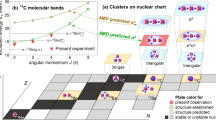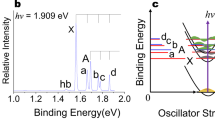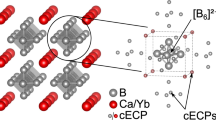Abstract
The chemistry of helium has hitherto been confined to experimental and theoretical analysis of small molecules containing three to five atoms in the gas phase. Here a new suggestion is made for compounds of helium deriving from a recent proposal that five-coordinate carbon might be captured as a frozen SN2 transition state. A series of logical steps, originally discussed as postings and comments to two blogs, led to the outcome described here of a central hypervalent atom bound on one face by a small cyclic carbon ligand, with the other free face having an interaction to a helium atom with the topological properties of a charge-shift rather than a covalent bond. Although high-level theory predicts these helium bonds to be quite short with relatively high stretching frequencies, the kinetic barriers to the loss of helium are predicted to be small, and are not increased by the strategy of having bulky substituents on the ring ligand.
This is a preview of subscription content, access via your institution
Access options
Subscribe to this journal
Receive 12 print issues and online access
$259.00 per year
only $21.58 per issue
Buy this article
- Purchase on Springer Link
- Instant access to full article PDF
Prices may be subject to local taxes which are calculated during checkout


Similar content being viewed by others
Change history
20 June 2014
The interactive version of the table shown in Fig. 1 of this Article is now additionally available at http://dx.doi.org/10.6084/m9.figshare.1009575. The online versions of the Article have been amended accordingly.
References
Cambridge crystallographic database http://www.ccdc.cam.ac.uk/ (2009).
Koch, W., Frenking, G., Gauss, J., Cremer, D. & Collins, J. R. Helium chemistry: theoretical predictions and experimental challenge. J. Am. Chem. Soc. 109, 5917–5934 (1987).
Grandinetti, F. Helium chemistry: a survey of the role of the ionic species. Int. J. Mass Spectrom. 237, 243–267 (2004).
Wong, M. W. Prediction of a metastable helium compound: HHeF. J. Am. Chem. Soc. 122, 6289–6290 (2000).
Grochala, W. On Chemical bonding between helium and oxygen. Pol. J. Chem. 83, 87–122 (2009).
Zou, W., Liu, Y. & Boggs, J. E. Theoretical study of RgMF (Rg = He, Ne; M = Cu, Ag, Au): Bonded structures of helium. Chem. Phys. Lett. 482, 207–210 (2009).
Lewars, E. G. Helium Compounds, in Book of Modeling Marvels: Computational Anticipation of Novel Molecules (Springer, 2008).
Krapp, A. & Frenking, G. Is this a chemical bond? A theoretical study of Ng2@C60 (Ng = He, Ne, Ar, Kr, Xe). Chem. Eur. J. 13, 8256–8270 (2007).
Cerpa, E., Krapp, A., Flores-Moreno, R., Donald, K. J. & Merino, G. Influence of endohedral confinement on the electronic interaction between He atoms: A He2@C20H20 case study. Chem. Eur. J. 15, 1985–1990 (2009).
Cerpa, E., Krapp, A., Vela, A. & Merino, G. The implications of symmetry of the external potential on bond paths. Chem. Eur. J. 14, 10232–10234 (2008).
Bader, R. F. W. Atoms in Molecules: a Quantum Theory (Oxford Univ. Press, 1990).
Zou, W., Liu, Y., Liu, W., Wang, T. & Boggs, J. E. He@Mo6Cl8F8: A stable complex of helium. J. Phys. Chem. A 114, 646–651 (2010).
Rzepa, H. S. The importance of being bonded. Nature Chem. 1, 510–512 (2009).
Shaik, S., Danovich, D., Wu, W. & Hiberty, P. C. Charge-shift bonding and its manifestations in chemistry. Nature Chem. 1, 443–449 (2009).
Alvarez, S., Hoffmann, R. & Mealli, C. A bonding quandary - or - a demonstration of the fact that scientists are not born with logic. Chem. Eur. J. 15, 8358–8373 (2009).
Pierrefixe, S. C. A. H., van Stralen, S. J. M., van Stralen, J. N. P., Guerra, C. F. & Bickelhaupt, F. M. Hypervalent carbon atom: “Freezing” the SN2 transition state. Angew. Chem. Int. Ed. 48, 6469–6471 (2009).
Bachrach, S. M. Pentacoordinate Carbon? http://comporgchem.com/blog/?p=385 (2009).
Fisher, E. L. & Lambert, T. H. Leaving group potential of a substituted cyclopentadienyl anion toward oxidative addition. Org. Lett. 11, 4108–4110 (2009).
Rzepa, H. S. Capturing Pentacoordinate Carbon? http://www.ch.imperial.ac.uk/rzepa/blog/?p=783 and http://www.ch.imperial.ac.uk/rzepa/blog/?p=811 (2009).
Jutzi, P. et al. The (Me5C5)Si+ cation: A stable derivative of HSi+. Science 305, 849–851 (2004).
Rzepa, H. S. It's penta-coordinate carbon Spock – but not as we know it! http://www.ch.imperial.ac.uk/rzepa/blog/?p=845 (2009).
Tonner, R., Heydenrych, G. & Frenking, G. First and second proton affinities of carbon bases. ChemPhysChem 9, 1474–1481 (2008).
Rzepa, H. S. It's Hexa-coordinate carbon Spock - but not as we know it! http://www.ch.imperial.ac.uk/rzepa/blog/?p=878 (2009).
Dohmeier, C., Köppe, R., Robl, C. & Schnöckel, H. Kristallstruktur von [Cp*BBr][AlBr4]. J. Organomet. Chem. 487, 127–130 (1995).
Takanashi, K. et al. Tetrakis(trimethylsilyl)cyclobutadiene dianion alkaline earth metal salts: new members of the 6π-electron aromatics family. Eur. J. Inorg. Chem. 1752–1755 (2008).
Chiang, T., Kerber, R. C., Kimball, S. D. & Lauher, J. W. (η3-Triphenyl-cyclopropenyl)tricarbonylcobalt. Inorg. Chem. 18, 1687–1691 (1979).
Casher, O. & Rzepa, H. S. SemanticEye: A semantic web application to rationalize and enhance chemical electronic publishing. J. Chem. Inf. Model. 46, 2396–2411 (2006).
Dixon, D. A., de Jong, W. A., Peterson, K. A. & McMahon, T. B. Methyl cation affinities of rare gases and nitrogen and the heat of formation of diazomethane. J. Phys. Chem. A 109, 4073–4080 (2005).
Tarnopolsky, A., Karton, A., Sertchook, R., Vuzman D., Martin, J. M. L. Double-hybrid functionals for thermochemical kinetics. J. Phys. Chem.A 112, 3–8 (2008).
Goerigk, L., Moellmann, J. & Grimme, S. Computation of accurate excitation energies for large organic molecules with double-hybrid density functionals. Phys. Chem. Chem. Phys. 11, 4611–4620 (2009).
Radom, L., Gill, P. M. W., Wong, M. W. & Nobes, R. H. Multiply-charged cations: remarkable structures and stabilities. Pure Appl. Chem. 60, 183–188 (1988).
Becke, A. D. & Edgecombe, K. E. A simple measure of electron localization in atomic and molecular systems. J. Chem. Phys. 92, 5397–5403 (1990).
Savin, A., Silvi, B. & Coionna, F. Topological analysis of the electron localization function applied to delocalized bonds. Can. J. Chem. 74, 1088–1096 (1996).
Avelar, A., Tham, F. S. & Reed, C. A. Superacidity of boron acids H2(B12X12) (X=Cl, Br). Angew. Chem. Int Ed. 48, 3491–3493 (2009).
Author information
Authors and Affiliations
Corresponding author
Ethics declarations
Competing interests
The author declares no competing financial interests.
Rights and permissions
About this article
Cite this article
Rzepa, H. The rational design of helium bonds. Nature Chem 2, 390–393 (2010). https://doi.org/10.1038/nchem.596
Received:
Accepted:
Published:
Issue Date:
DOI: https://doi.org/10.1038/nchem.596
This article is cited by
-
Nonclassical tetracoordinate carbon in exohedral complexes of hexaprismanes X12H12Cn (X = C, Si, Ge; n = 1–3)
Russian Chemical Bulletin (2023)
-
On the position of helium and neon in the Periodic Table of Elements
Foundations of Chemistry (2018)
-
Hypercoordinated carbon in C-doped boron fullerenes: a quantum chemical study
Structural Chemistry (2017)
-
Addendum: The rational design of helium bonds
Nature Chemistry (2014)



